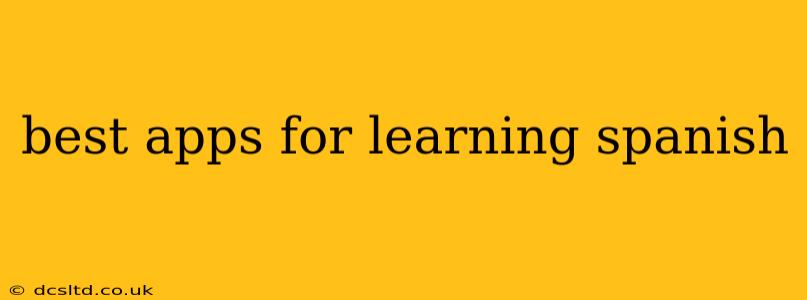Learning a new language can be a rewarding journey, opening doors to new cultures and experiences. If you're aiming for Spanish fluency, you're in luck! The app market offers a wealth of resources to help you achieve your goals. This comprehensive guide explores some of the best apps for learning Spanish, catering to different learning styles and preferences. We'll delve into their strengths and weaknesses to help you choose the perfect app to kickstart (or boost!) your Spanish learning adventure.
What Makes a Great Spanish Learning App?
Before we dive into specific apps, let's define what makes a truly effective language learning app. A top-tier app should offer:
- Engaging Content: Learning should be fun! The best apps utilize diverse methods like gamification, interactive exercises, and multimedia content to keep you motivated.
- Structured Curriculum: A clear progression from beginner to advanced levels ensures you build a solid foundation and don't get overwhelmed.
- Personalized Learning: Apps that adapt to your learning pace and strengths provide a more efficient and satisfying experience.
- Practical Application: The ability to practice speaking, listening, reading, and writing is crucial for real-world fluency.
- Community Features: Interacting with other learners or native speakers can enhance your motivation and provide valuable feedback.
Top Spanish Learning Apps: A Detailed Look
Now, let's explore some of the leading contenders in the Spanish-learning app arena.
Duolingo: The Gamified Giant
Duolingo is arguably the most well-known language learning app. Its gamified approach, with points, streaks, and leaderboards, keeps learners engaged. Duolingo offers a structured curriculum covering vocabulary, grammar, and pronunciation. However, its reliance on gamification might not suit everyone, and some users find the content somewhat simplistic for advanced learners.
Babbel: Focus on Real-World Conversations
Babbel emphasizes practical conversational skills. Its lessons are designed to prepare you for real-world interactions, focusing on everyday situations and vocabulary. Babbel's curriculum is well-structured, and it provides personalized feedback. While generally well-regarded, Babbel is a subscription-based app, which can be a drawback for some.
Rosetta Stone: Immersion and Contextual Learning
Rosetta Stone employs an immersion method, focusing on visual association and contextual learning. It minimizes direct translation, aiming to build intuitive understanding. While effective for some, this approach can be challenging for those who prefer more explicit grammar explanations. Like Babbel, Rosetta Stone is a subscription service.
Memrise: Mnemonics and Memorization Techniques
Memrise utilizes mnemonics and other memorization techniques to help you retain vocabulary and grammar rules. Its quirky approach and use of flashcards and images make learning more engaging. Memrise offers a free version with limited content, but its full features require a subscription.
Drops: Visual Learning for Vocabulary Building
Drops focuses on vocabulary building through visually appealing flashcards and games. It's excellent for quickly expanding your vocabulary, but it doesn't delve as deeply into grammar as other apps. Drops is ideal for supplementing other learning methods, rather than being a complete standalone solution.
HelloTalk: Connecting with Native Speakers
HelloTalk is unique in its emphasis on connecting learners with native Spanish speakers. It offers features for language exchange, voice and video chat, and even translation assistance. While not a structured learning app, it provides invaluable opportunities for practical conversation practice.
H2: Which App is Right for Me?
Choosing the best app depends on your learning style, budget, and goals. Consider these factors:
- Your Learning Style: Do you prefer gamified learning, structured lessons, or immersion?
- Your Budget: Many apps offer free versions with limited content, while others require subscriptions.
- Your Learning Goals: Are you aiming for basic conversational skills, or are you striving for fluency?
H2: Frequently Asked Questions (FAQs)
This section addresses common queries regarding Spanish learning apps.
H3: Are these apps enough to become fluent in Spanish?
While these apps are excellent tools, they are generally not sufficient on their own to achieve full fluency. Consistent practice, immersion experiences (like traveling to a Spanish-speaking country or engaging with native speakers), and supplementary learning materials are crucial for true fluency.
H3: How much do these apps cost?
Costs vary. Some apps offer free versions with limited features, while others require monthly or annual subscriptions. Check the individual app stores for the latest pricing information.
H3: Can I use these apps offline?
The availability of offline access differs between apps. Check each app's features to see if it offers offline functionality. This is crucial if you plan to use the app while traveling or in areas with limited internet access.
H3: Which app is best for beginners?
For beginners, Duolingo and Babbel are popular choices due to their structured curricula and clear progression of lessons.
Conclusion: Embark on Your Spanish Learning Journey
With a multitude of excellent apps available, finding the perfect fit for your Spanish learning journey is entirely feasible. Experiment with a few different apps, utilize their free trials, and discover the methods that resonate best with your learning style and objectives. Remember, consistency and active engagement are key to success, regardless of the app you choose. ¡Buena suerte! (Good luck!)
